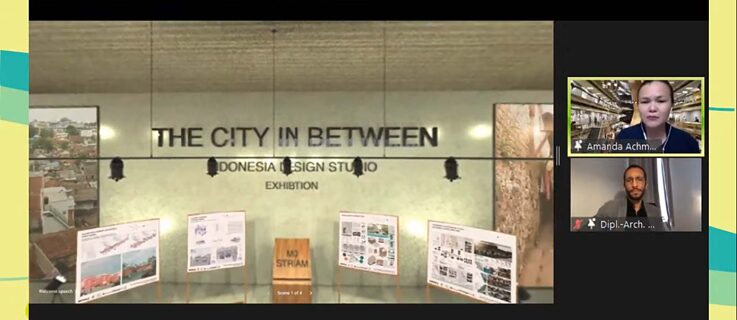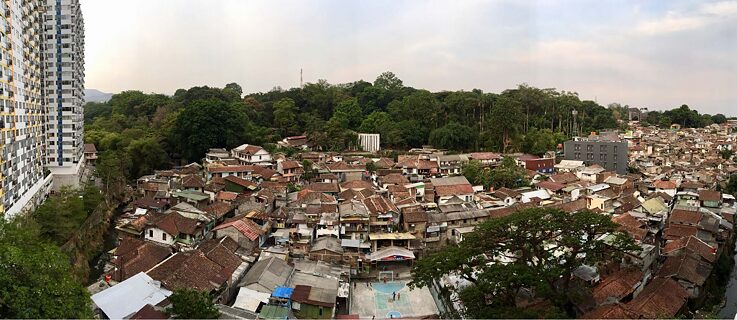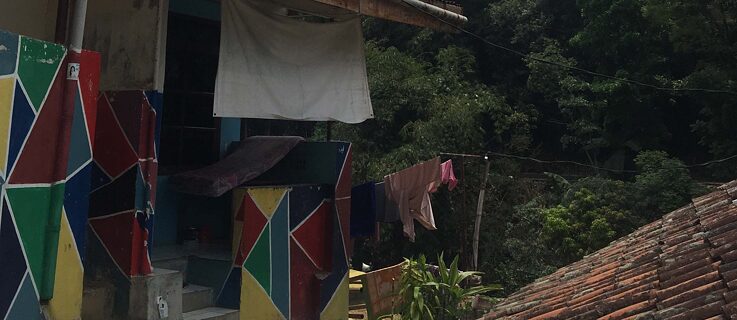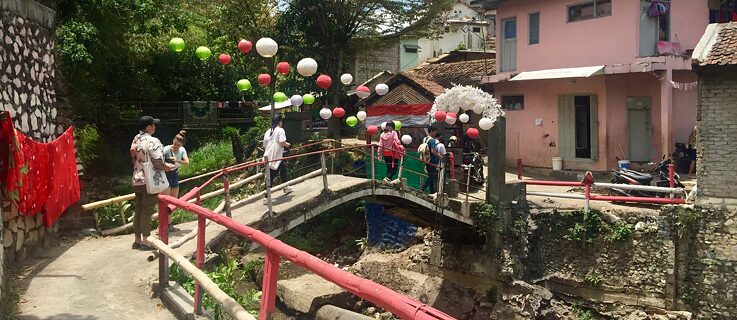Urban Informality, Sustainability and Post-Pandemic Resilience
At the end of 2019, students from the University of Stuttgart, the Bandung Institute of Technology and the University of Melbourne participated in the Travelling Studio “The City In-Between, Designing with Urban Informality in Bandung, Indonesia”. Their aim was to learn more about informal urban developments and to explore the possibility of more inclusive planning along the Cikapundung riverscape. The research and design results were to be presented live in 2020, but due to the COVID-19 pandemic the exhibition shifted to digital space. Held in collaboration with the Goethe-Institut Bandung, the two panel discussions that were broadcast via YouTube, that widen the exhibition through actual and artistic perspectives.
Imagining the In-Between City through Art and Design
Opening the first panel, lecturers presented an overview of the design agenda and the focus area of the study along the Cikapundung riverscape. Urban kampungs on the riverbanks are facing competition from tourism projects and commercial developments for the use of this space. At a time when urban gentrification is gaining momentum, ecological disasters such as floods are increasing in frequency while social crises become more and more complex because of rampant development. These phenomena threaten Bandung’s future urban space.The study set three river segments as focus areas: the downstream segment of “Braga”, a cultural heritage area; the midstream segment wedged between the Cihampelas commercial area and the ITB campus; and the upstream segment from the Cikapundung Terrace to Ciumbuleuit.
The Downstream Group shared its narrative on “Kampung Braga”, an area of utmost importance regarding the history of Bandung yet vulnerable to gentrification and demolition because of its strategic location for economic activities. New high-rise buildings now “close off” the public side of Kampung Braga. The group proposed the Binawarga and Binaruang programs to encourage more inclusive planning. The Binawarga program engaged in social community development, whereas the Binaruang program focused on the physical aspects of development.
Seruni Fauzia Lestari (Kolektif Agora) highlighted the other side of “Kampung Braga”, the epitome of Bandung’s cultural heritage containing traces of colonialism. Colonialism manifests itself not only physically through art deco design but also through the inherited mindset of the authorities in our country. We see this, for example, in the way the local government claims this cultural heritage space as a tourist attraction in the name of the greater good while alienating its own people by doing so. One could replicate the study of Kampung Braga on a larger scale (even in places not considered part of our cultural heritage) to analyze how this post-colonial way of thinking often emerges to threaten our spaces.
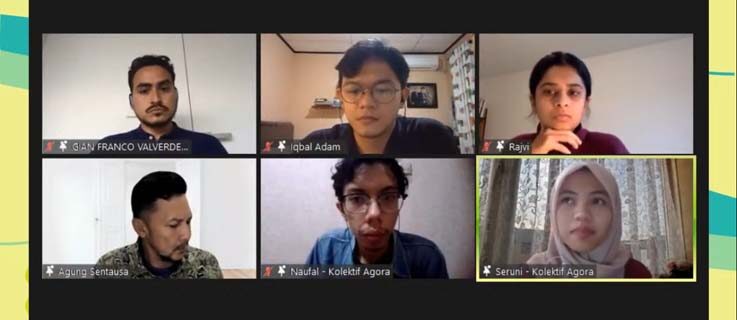 Panel 1: Envisioning the In-between City through the lens of art and design. Seruni from the Agora Collective responded to a presentation from the down stream group. | © YouTube Goethe-Institut Indonesien
Panel 1: Envisioning the In-between City through the lens of art and design. Seruni from the Agora Collective responded to a presentation from the down stream group. | © YouTube Goethe-Institut Indonesien
The next presentation featured the midstream segment with its many contrasts. Local communities value the natural condition of the river but are also drawn to its more formal aspects, for example that the river is no longer an isolated stream and has become a water source for the surrounding area. The Midstream Group’s research focused on the kind of design that would be suitable for the ever-changing kampung spaces. Bandung-based artist and ITB lecturer Tisna Sanjaya thinks of design as being very artistic, poetic and worthy of being presented in its own social art space. The proposed designs intend to provide a more humane perspective for this midstream kampung segment.
The Upstream Group examined the dynamics between the physical space of the kampung and the social aspects of its community. The most problematic aspect was that the inhabitants did not own the land and were thus not free to redesign the space in accordance with their respective needs. Naufal Rofi Indriansyah (Kolektif Agora) pointed out that any upstream interventions would have major consequences for the midstream and downstream segments. The study provided a detailed breakdown of current developments in the upstream area for use in follow-up midstream and downstream studies.
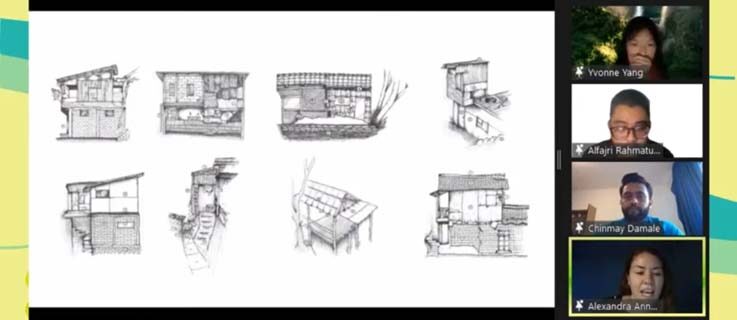 Panel 1: Envisioning the In-between City through the lens of art and design. Presentation from up stream group. | © YouTube Goethe-Institut Indonesien
Panel 1: Envisioning the In-between City through the lens of art and design. Presentation from up stream group. | © YouTube Goethe-Institut Indonesien
Post-pandemic Urbanism: Reflections on Informality, Sustainability and Urban Resilience
The second panel, moderated by Dr. Wiryono Raharjo (Universitas Islam Indonesia) discussed the global pandemic situation and the many ways it has exposed the inequalities in cities around the world. This applies especially to access to urban facilities, open green spaces, and affordable housing.Dr. Tisna Sanjaya has embraced the current pandemic as a trigger for reflection. In his view as an artist, our bodies are machines with souls. Because of the pandemic, we are unable to access this machine and the materials that we normally use, but we can still create by using our own bodies. His Imah Budaya (Ibu) Cigondewah, which he established in 2007 on the banks of the Cigondewah river, aims to raise awareness through art to adopt and adapt sustainable urban living modes.
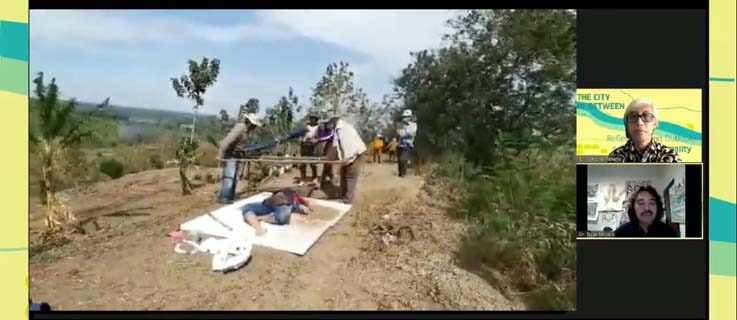 Panel 2: (Post)Pandemic Urbanism: Reflections on Informality, Sustainability, and Resilience of Indonesian Cities. Presentation from Dr. Tisna Sanjaya | © YouTube Goethe-Institut Indonesien
Panel 2: (Post)Pandemic Urbanism: Reflections on Informality, Sustainability, and Resilience of Indonesian Cities. Presentation from Dr. Tisna Sanjaya | © YouTube Goethe-Institut Indonesien
The next session, “Kampung-isation of Indonesian Cities during the Pandemic: Emerging Virtual and Spatial Tactics”, was presented by Dr. Amanda Achmadi and Dr. Sidh Sintusingha (University of Melbourne). The Indonesian government is known for its “laid-back” attitude—even during the pandemic. This is in contrast to local communities, which have their own tactics to protect themselves. Their usually informal activities enable them to be flexible.
That social distancing is a luxury for most people was highlighted by Ir. Budi Faisal and Asep Darmana (ITB) in their presentation entitled “Lessons Learned from the Informal Neighborhood During the Pandemic”. People have two choices: either leave home to earn a living and get infected or starve to death. The social capital they share enables them to look after one another. It should be possible to replicate this approach in a larger community as a potent force to face the pandemic.
This kind of social capital is not exclusive to Indonesia. It is also evident in many other countries. For example, Dipl.-Arch. MSc. Yassine Moustanjidi and Prof. Astrid Ley (University of Stuttgart) presented a case study about communal initiatives to secure food supplies in Cape Town, South Africa. Similarly, the people of Stuttgart took the initiative to distribute via platform nebenan.de food packages, provide baby-sitting services, and work together to face the current situation.
 Panel 2: (Post)Pandemic Urbanism: Reflections on Informality, Sustainability, and Resilience of Indonesian Cities. Presentation from Prof. Astrid Ley | © YouTube Goethe-Institut Indonesien
Panel 2: (Post)Pandemic Urbanism: Reflections on Informality, Sustainability, and Resilience of Indonesian Cities. Presentation from Prof. Astrid Ley | © YouTube Goethe-Institut Indonesien
In the exposition session’s final presentation, Kamil Muhammed (Architecture Sans Frontières – Indonesia) shared his observations gained while working with kampung communities in Jakarta. He elaborated on the role of the architect as facilitator in participatory kampung design, i.e. that involves the residents. Kamil revealed that many kampung communities in Indonesia had already proven their resilience and the ability to adapt to the current situation. At the same time, the formal sectors of cities have reaped the benefits of the flexibility and reliability of kampung community activities in the informal economy sector.
You can visit this digital exhibition "The City in-Between" and obtain further information by accessing the exhibition brochure.
